System For Determining Ambient Temperature
Aljabari; Mohammad
U.S. patent application number 16/174250 was filed with the patent office on 2019-02-28 for system for determining ambient temperature. The applicant listed for this patent is Honeywell International Inc.. Invention is credited to Mohammad Aljabari.
| Application Number | 20190069344 16/174250 |
| Document ID | / |
| Family ID | 40676624 |
| Filed Date | 2019-02-28 |


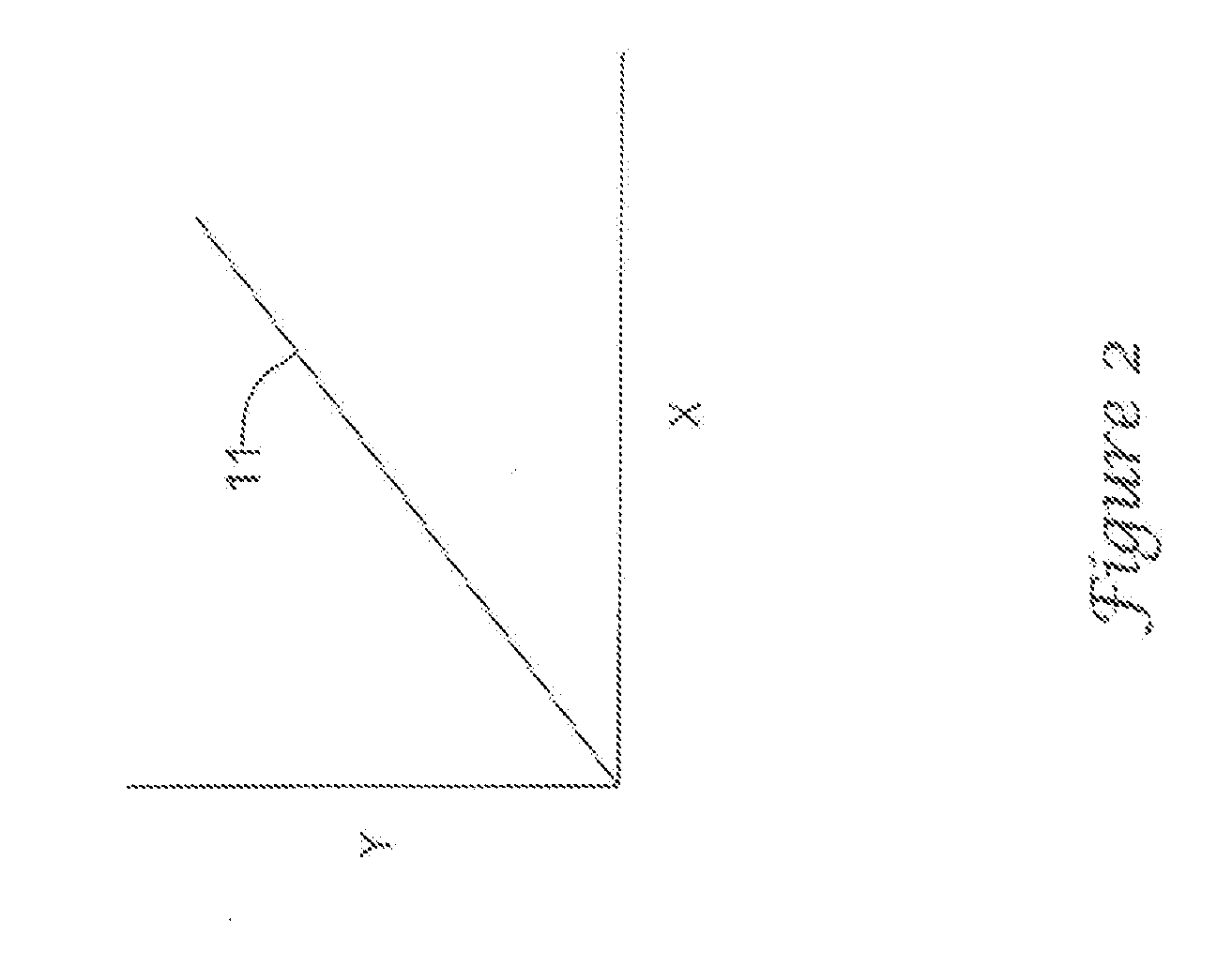

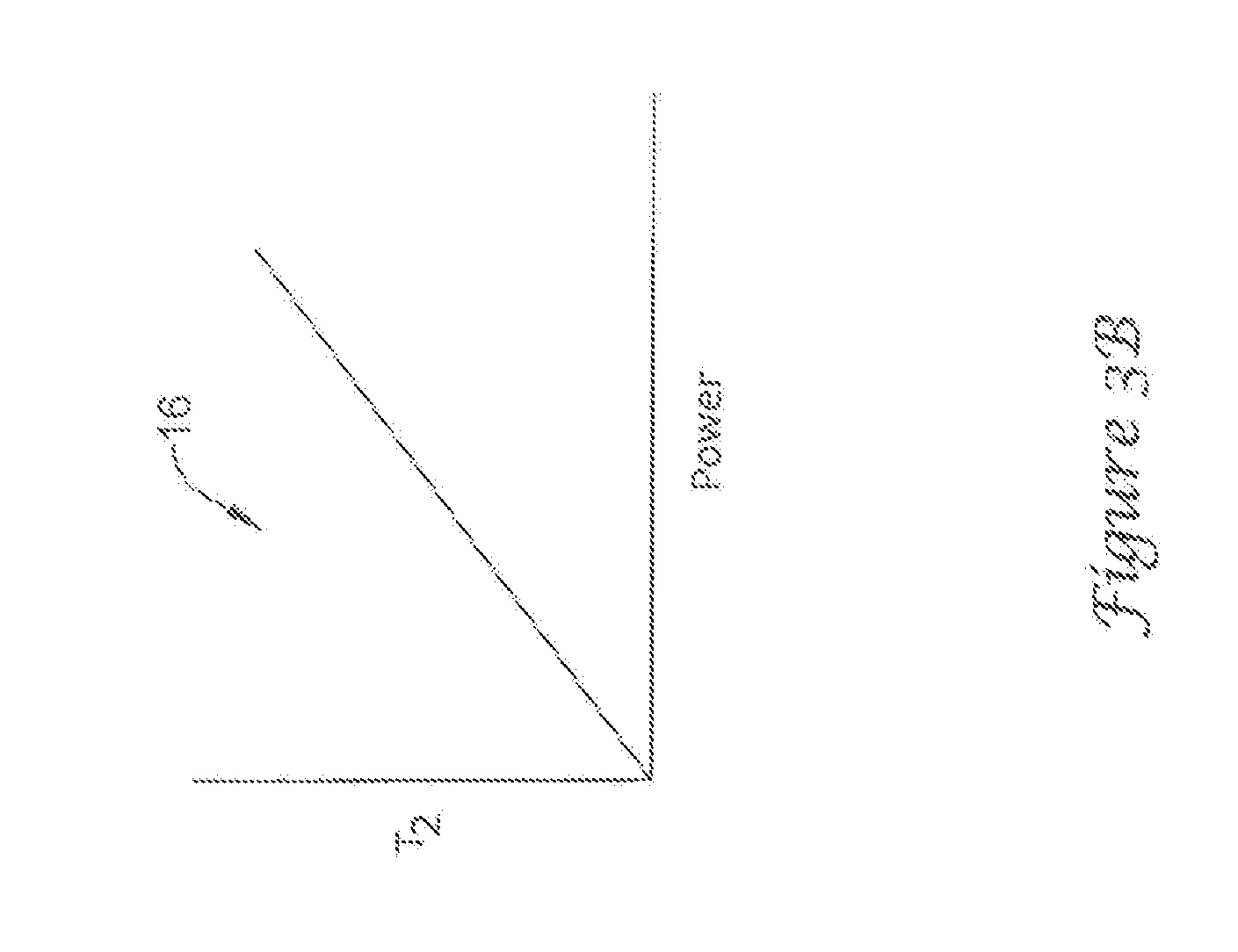

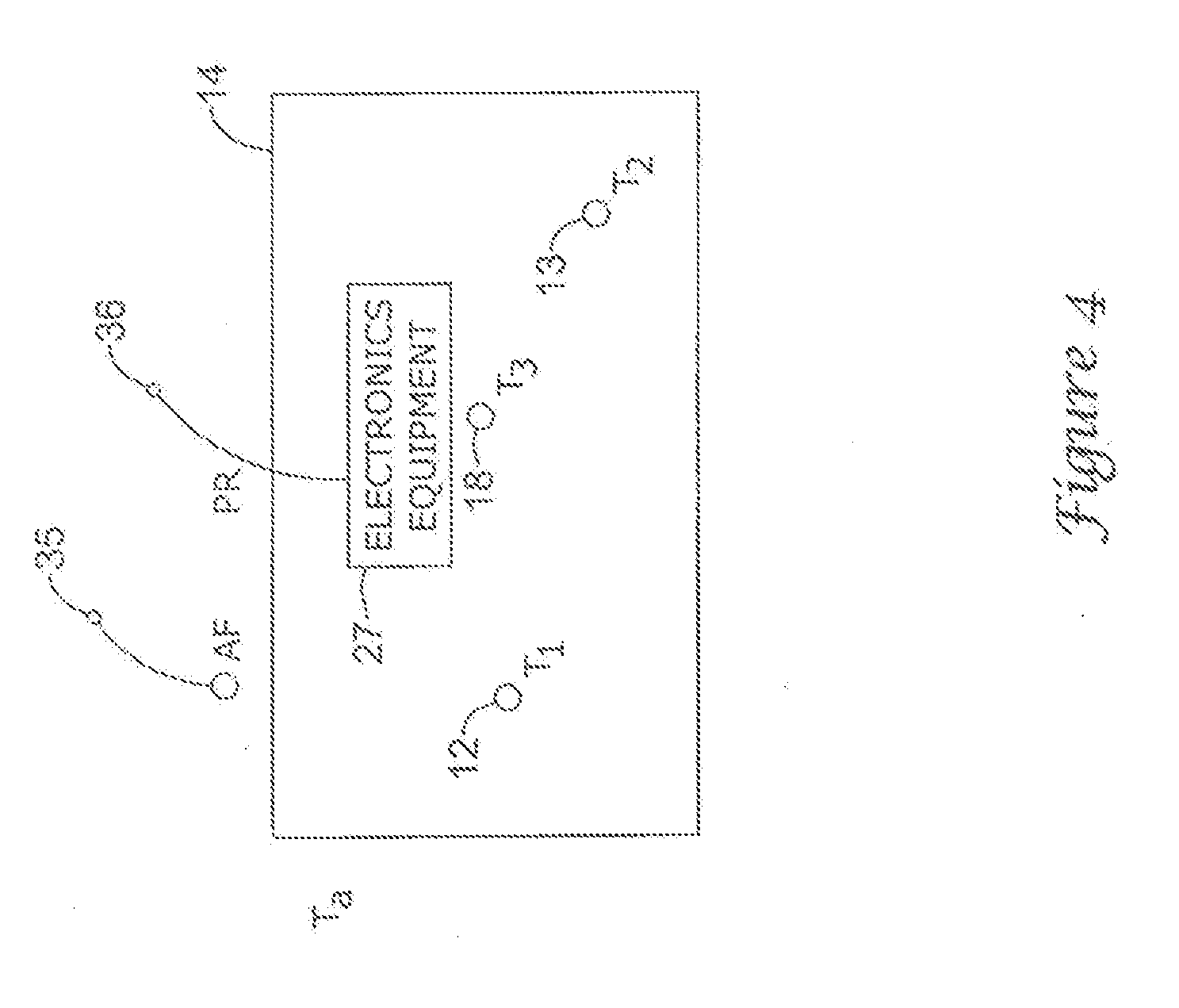
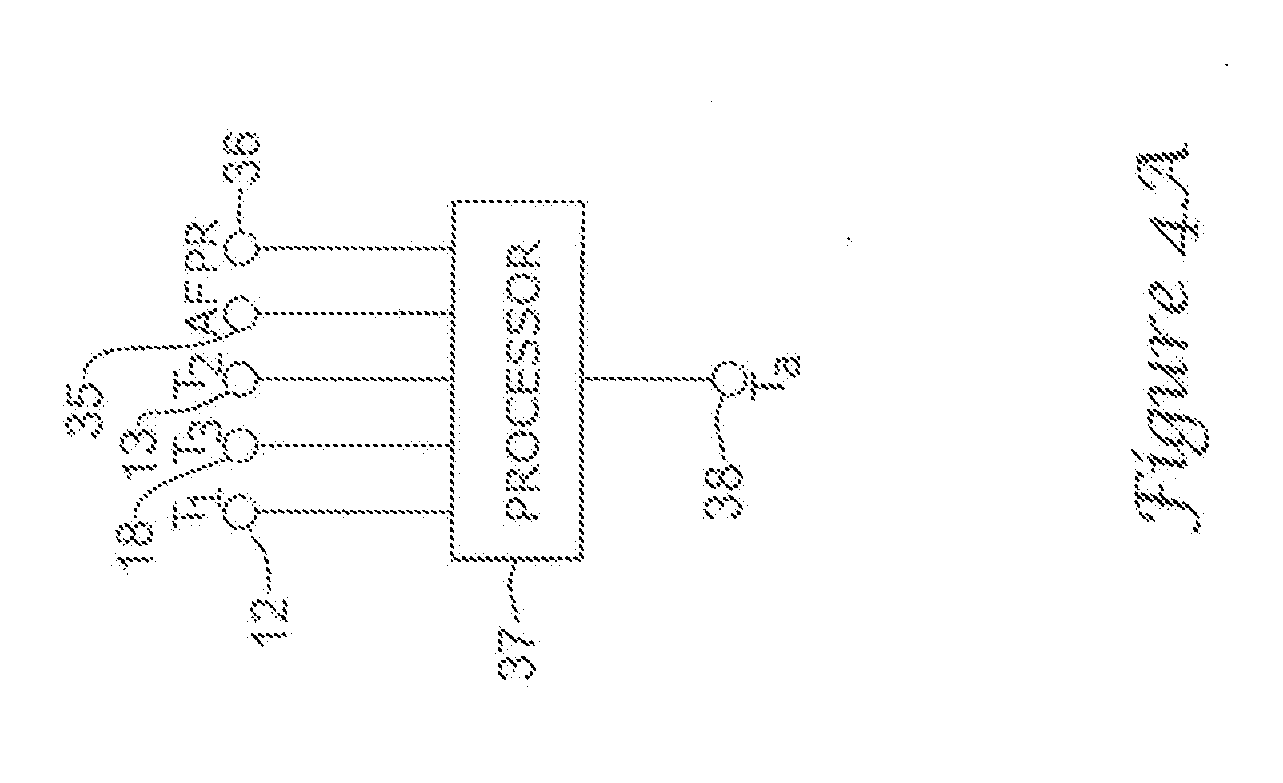
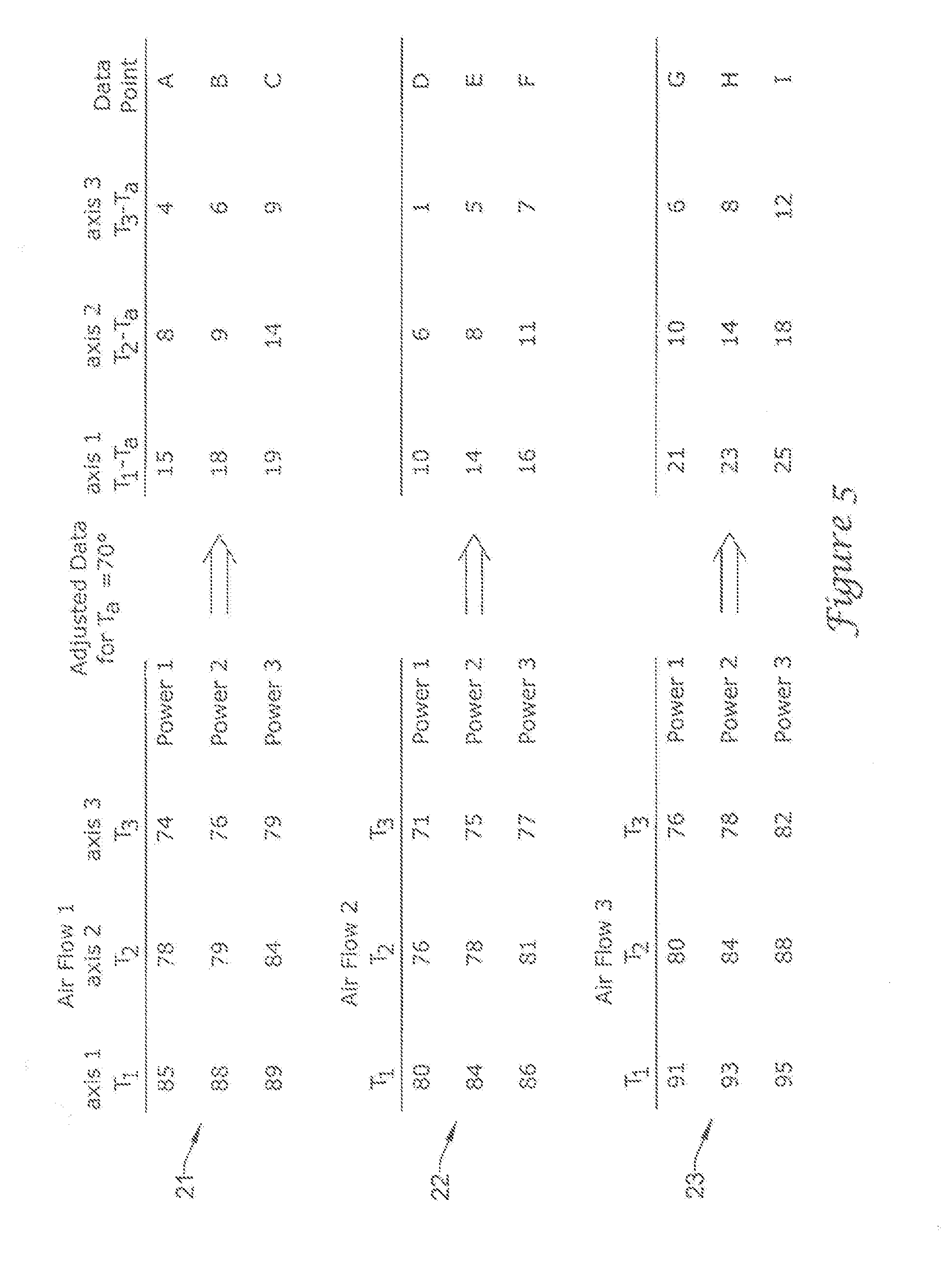

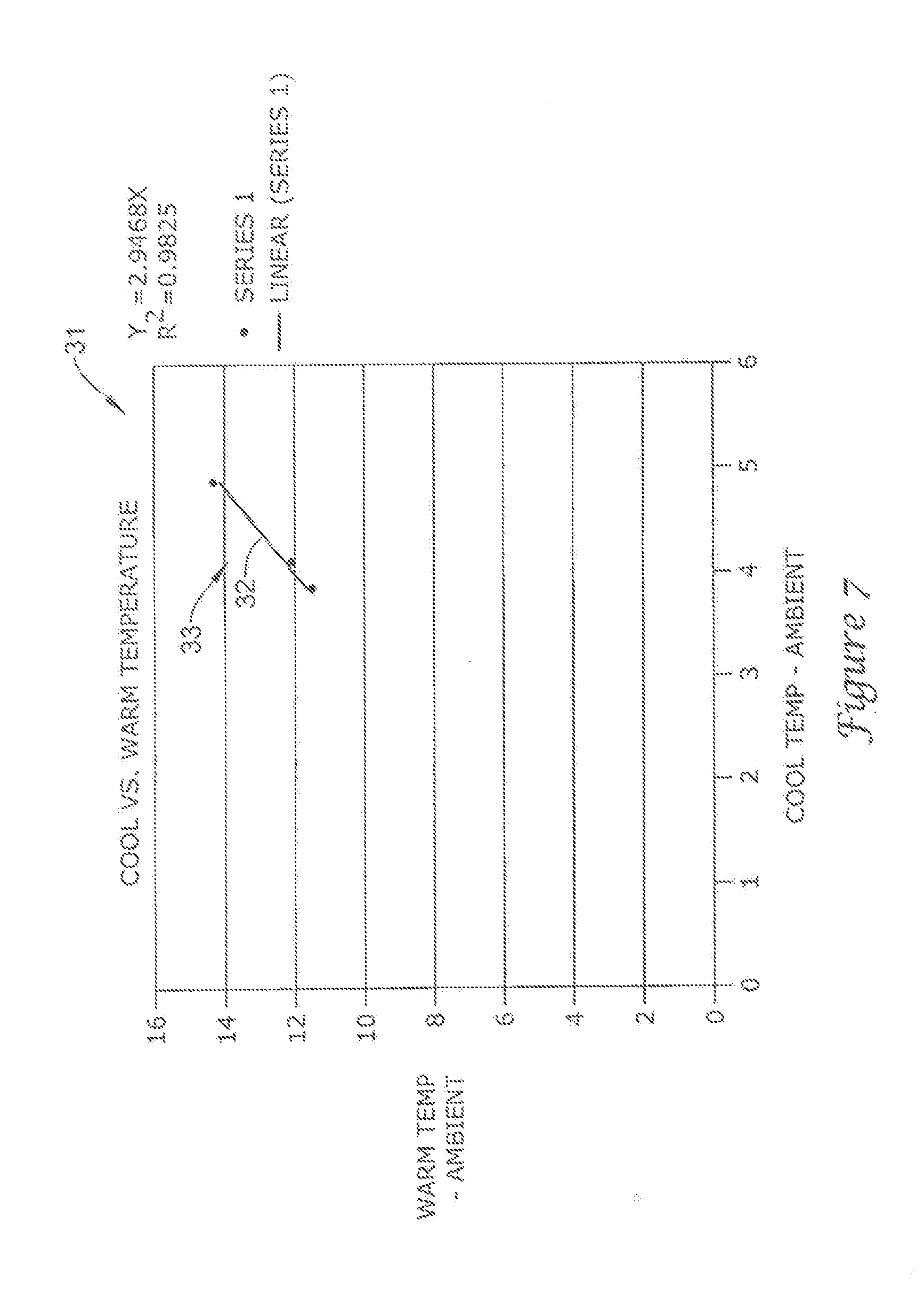

View All Diagrams
| United States Patent Application | 20190069344 |
| Kind Code | A1 |
| Aljabari; Mohammad | February 28, 2019 |
SYSTEM FOR DETERMINING AMBIENT TEMPERATURE
Abstract
A mechanism for indicating ambient temperature of an enclosure from temperatures determined within the enclosure. The temperatures may be obtained from two or more sensors at each of two or more locations within the enclosure. The enclosure may include an apparatus inside such as electronics of which power consumption may be determined. Data including temperatures of two locations within the enclosure at various electronics power consumption levels may be entered into a 2-D plot. An approximation of the 2-D plot may be effected with an appropriate equation to be solved for ambient temperature. The data of the 2-D plot plus temperatures of a third location and air flow levels in the enclosure may be entered into a 3-D plot. An approximation of the 3-D plot may be effected with an appropriate equation to be solved for ambient temperature.
| Inventors: | Aljabari; Mohammad; (Brooklyn Park, MN) | ||||||||||
| Applicant: |
|
||||||||||
|---|---|---|---|---|---|---|---|---|---|---|---|
| Family ID: | 40676624 | ||||||||||
| Appl. No.: | 16/174250 | ||||||||||
| Filed: | October 29, 2018 |
Related U.S. Patent Documents
| Application Number | Filing Date | Patent Number | ||
|---|---|---|---|---|
| 15085663 | Mar 30, 2016 | 10154541 | ||
| 16174250 | ||||
| 14559114 | Dec 3, 2014 | |||
| 15085663 | ||||
| 13434813 | Mar 29, 2012 | 8954288 | ||
| 14559114 | ||||
| 11950394 | Dec 4, 2007 | 8280673 | ||
| 13434813 | ||||
| Current U.S. Class: | 1/1 |
| Current CPC Class: | G01K 1/20 20130101; G01K 7/427 20130101; G01K 7/42 20130101; H05B 1/02 20130101 |
| International Class: | H05B 1/02 20060101 H05B001/02; G01K 1/20 20060101 G01K001/20; G01K 7/42 20060101 G01K007/42 |
Claims
1. A thermostat for providing control signals to one or more pieces of equipment, comprising: a housing; a temperature sensor situated within the housing for reporting a measure of the temperature within the housing; a memory for storing two or more coefficients that at least partially define a relationship between an ambient temperature outside of the housing and the measure of the temperature within the housing reported by the temperature sensor, over two or more power consumption levels of one or more active electronic components within the housing; a controller in communication with the temperature sensor and the memory, the controller configured to: determine a measure related to the ambient temperature outside of the housing based, at least in part, on at least some of the two or more coefficients stored in the memory and the measure of the temperature within the housing reported by the temperature sensor; and provide one or more control signals to control the one or more pieces of equipment based at least in part on the measure related to the ambient temperature outside of the housing determined by the controller and a temperature set point.
2. The thermostat of claim 1, wherein the two or more coefficients are determined during a calibration procedure, wherein the two or more coefficients are calculated at least in part using measures of the temperature within the housing reported by the temperature sensor at each of two or more power consumption levels of one or more active electronic components within the housing.
3. The thermostat of claim 2, wherein the two or more coefficients are calculated at least in part using measures of the temperature within the housing reported by the temperature sensor at each of two or more power consumption levels of one or more active electronic components within the housing under a stable ambient temperature condition.
4. The thermostat of claim 2, wherein the two or more coefficients are calculated at least in part using measures of the temperature within the housing reported by the temperature sensor at each of two or more power consumption levels of one or more active electronic components within the housing under each of two or more stable ambient temperature conditions.
5. The thermostat of claim 1, wherein at one or more power consumption level of the one or more active electronic components, the measure of the temperature within the housing reported by the temperature sensor is at least 4 degrees F. warmer than an actual ambient temperature outside of the housing, while a difference between the measure related to the ambient temperature determined by the controller and the actual ambient temperature is less than 1.5 degrees F.
6. The thermostat of claim 1, wherein at one or more power consumption level of the one or more active electronic components, the measure of the temperature within the housing reported by the temperature sensor is at least 6 degrees F. warmer than an actual ambient temperature outside of the housing, while a difference between the measure related to the ambient temperature determined by the controller and the actual ambient temperature is less than 1.5 degrees F.
7. The thermostat of claim 1, wherein at one or more power consumption level of the one or more active electronic components, the measure of the temperature within the housing reported by the temperature sensor is at least 6 degrees F. warmer than an actual ambient temperature outside of the housing, while a difference between the measure related to the ambient temperature determined by the controller and the actual ambient temperature is less than 1.0 degrees F.
8. The thermostat of claim 1, wherein at one or more power consumption level of the one or more active electronic components, the measure of the temperature within the housing reported by the temperature sensor is at least 8 degrees F. warmer than an actual ambient temperature outside of the housing, while the difference between the measure related to the ambient temperature determined by the controller and the actual ambient temperature is less than 1.5 degrees F.
9. A thermostat for providing control signals to one or more pieces of equipment, comprising: a housing; a temperature sensor situated within the housing for reporting a temperature within the housing; a memory for storing two or more coefficients that at least partially define a relationship between an ambient temperature outside of the housing and the temperature within the housing reported by the temperature sensor, over two or more power consumption levels of one or more active electronic components within the housing; a controller in communication with the temperature sensor and the memory, the controller configured to: determine an ambient temperature outside of the housing based on at least some of the two or more coefficients stored in the memory and the temperature within the housing reported by the temperature sensor; wherein at one or more power consumption levels of the one or more active electronic components, the temperature within the housing reported by the temperature sensor is at least 4 degrees F. warmer than an actual ambient temperature outside of the housing, while a difference between the ambient temperature determined by the controller and the actual ambient temperature is less than 1.5 degrees F.; provide one or more control signals to control the one or more pieces of equipment based at least in part on the ambient temperature determined by the controller and a temperature set point.
10. The thermostat of claim 9, wherein at one or more power consumption level of the one or more active electronic components, the temperature within the housing reported by the temperature sensor is at least 6 degrees F. warmer than the actual ambient temperature outside of the housing, while the difference between the ambient temperature determined by the controller and the actual ambient temperature is less than 1.5 degrees F.
11. The thermostat of claim 9, wherein at one or more power consumption level of the one or more active electronic components, the temperature within the housing reported by the temperature sensor is at least 6 degrees F. warmer than the actual ambient temperature outside of the housing, while the difference between the ambient temperature determined by the controller and the actual ambient temperature is less than 1.0 degrees F.
12. The thermostat of claim 9, wherein at one or more power consumption level of the one or more active electronic components, the temperature within the housing reported by the temperature sensor is at least 8 degrees F. warmer than the actual ambient temperature outside of the housing, while the difference between the ambient temperature determined by the controller and the actual ambient temperature is less than 1.5 degrees F.
13. The thermostat of claim 9, wherein the relationship that is at least partially defined by the two or more coefficients comprises an empirical mathematical model.
14. The thermostat of claim 13, wherein at least some of the two or more coefficients represent weights in the empirical mathematical model.
15. The thermostat of claim 13, wherein the memory stores the empirical mathematical model, including the two or more coefficients of the empirical mathematical model.
16. A thermostat for providing control signals to one or more pieces of equipment, comprising: a housing; a temperature sensor situated within the housing for reporting a temperature within the housing; a memory for storing a relationship between an ambient temperature outside of the housing and the temperature within the housing reported by the temperature sensor, over two or more power consumption levels of one or more active electronic components within the housing; a controller in communication with the temperature sensor and the memory, the controller configured to: determine an ambient temperature outside of the housing based on the relationship stored in the memory and the temperature within the housing reported by the temperature sensor at a current power consumption level of the one or more active electronic components within the housing; wherein at the current power consumption level of the one or more active electronic components, the temperature within the housing reported by the temperature sensor is at least 4 degrees F. warmer than an actual ambient temperature outside of the housing, while a difference between the ambient temperature determined by the controller and the actual ambient temperature is less than 1.5 degrees F.; provide one or more control signals to control the one or more pieces of equipment based at least in part on the ambient temperature determined by the controller and a temperature set point.
17. The thermostat of claim 16, wherein the relationship comprises an empirical mathematical model that includes two or more coefficients that represent weights.
18. The thermostat of claim 16, wherein at the current power consumption level of the one or more active electronic components, the temperature within the housing reported by the temperature sensor is at least 6 degrees F. warmer than the actual ambient temperature outside of the housing, while the difference between the ambient temperature determined by the controller and the actual ambient temperature is less than 1.5 degrees F.
19. The thermostat of claim 16, wherein at the current power consumption level of the one or more active electronic components, the temperature within the housing reported by the temperature sensor is at least 6 degrees F. warmer than the actual ambient temperature outside of the housing, while the difference between the ambient temperature determined by the controller and the actual ambient temperature is less than 1.0 degrees F.
20. The thermostat of claim 16, wherein at the current power consumption level of the one or more active electronic components, the temperature within the housing reported by the temperature sensor is at least 8 degrees F. warmer than the actual ambient temperature outside of the housing, while the difference between the ambient temperature determined by the controller and the actual ambient temperature is less than 1.5 degrees F.
Description
[0001] This is a continuation of U.S. patent application Ser. No. 15/085,663, entitled "A System for Determining Ambient Temperature", filed Mar. 30, 2016, which is a continuation of U.S. patent application Ser. No. 14/599,114, entitled "A System for Determining Ambient Temperature", filed Jan. 16, 2015, which is a continuation of U.S. patent application Ser. No. 13/434,813, entitled "A System for Determining Ambient Temperature", filed Mar. 29, 2012, now U.S. Pat. No. 8,954,288, issued Feb. 10, 2015, which is a continuation of U.S. patent application Ser. No. 11/950,394, entitled "A System for Determining Ambient Temperature", filed Dec. 4, 2007, now U.S. Pat. No. 8,280,673, issued Oct. 2, 2012, all of which are incorporated herein by reference.
BACKGROUND
[0002] The present invention pertains to temperature sensing and particularly to indirect temperature determination.
SUMMARY
[0003] The invention is a mechanism for indicating an ambient temperature about an enclosure containing a device, from determined temperatures within the enclosure.
BRIEF DESCRIPTION OF THE DRAWING
[0004] FIG. 1 is a diagram of enclosure having possibly power consuming equipment and temperature sensors for providing temperatures from two locations in the enclosure;
[0005] FIG. 2 is a diagram of a straight line fitted to data from sensors in the enclosure plotted on a two-coordinate graph for determining ambient temperature from a fitted equation;
[0006] FIG. 3a a graph of a temperature of a first vicinity in the enclosure versus power;
[0007] FIG. 3b a graph of a temperature of a second vicinity in the enclosure versus power;
[0008] FIG. 3c is a graph resulting from a combining the graphs of FIGS. 3a and 3b into one of the first temperature of the first vicinity versus the temperature of the second vicinity of the enclosure;
[0009] FIG. 4 is a diagram of an enclosure of equipment having sensors for providing temperatures from three locations in the enclosure;
[0010] FIG. 4a is a diagram of a processor with inputs from various sensors pertinent to the enclosure;
[0011] FIG. 5 a table of data from sensors for three locations in the enclosure for various air flows and power consumption levels in the equipment in the enclosure;
[0012] FIG. 6 is a three-coordinate graph having a plot of the data of FIG. 5 which is plane-fitted with an equation;
[0013] FIG. 7 is a two-coordinate graph of cool versus warm temperatures; and
[0014] FIG. 8 is a three-coordinate graph having a plot of another set of data which is plane-fitted with an equation.
DESCRIPTION
[0015] Accurate ambient temperature sensing is needed in a thermostat application. Sensing temperature using thermistors, semiconductor temperature sensors, thermocouples or any other form of temperature sensors from within an enclosure of electronics or equipment may result in a temperature higher than the ambient air temperature surrounding the enclosure of the equipment or device. The term "ambient" used herein refers to the volume proximate to, external of and surrounding the enclosure. The difference between the ambient and the sensed temperature may vary and be affected by the amount of electrical energy needed to power the device, ventilation, how close or far the temperature sensors are from warm components of the device, air flow surrounding the enclosure and/or device, device materials and their thermal conductivities, and so forth. If the amount of heat generated inside the enclosure is low and constant, constant temperature compensation might be sufficient. But when the heat generated inside the case or enclosure is high and variable, computing the ambient temperature may become very challenging.
[0016] The invention may be used for enabling the device or a processor to calculate the ambient temperature by sensing two or more different temperature points within the enclosure. An algorithm used to calculate the ambient temperature may be independent of power consumption of the device.
[0017] Two or more temperature sensors may be placed in different locations within the enclosure of the device. In theory, any two locations that have different temperatures in steady state under a given load should work. In practice, one temperature sensor "T.sub.hot" may be placed close to the heat generating components. The other temperature sensor "T.sub.cool" may be placed in about the coldest location within the device. Under very stable ambient conditions, the temperatures may be sampled at different equipment or device power load conditions. The temperatures sampled may be used to generate equations in terms of power (by means of curve fitting). The equations may be regarded as approximations of two-dimensional and three-dimensional relationships which may be graphs, plots, representations, and/or the like.
[0018] The equations may include the following. T.sub.cool=T.sub.ambient+f(x)>T.sub.cool=determined cool temperature. x=power dissipated in the device. f(x)=heat rise with respect to power for the cool temperature sensor. T.sub.hot=T.sub.ambient+f(x)>T.sub.hot=determined hot temperature. x=power dissipated in the device. f(x)=heat rise with respect to power for the hot temperature sensor. From the system of two equations, x and T.sub.ambient are unknowns. Once these equations are solved, T.sub.ambient=f(T.sub.cool, T.sub.hot). And since T.sub.cool and T.sub.hot are determined values, ambient temperature may be calculated from them. f(x) may be approximated (i.e., fitted) to a linear function, but it can also be non-linear for increased accuracy; however, in the latter case f(x) would be more complicated to implement.
[0019] The present approach does not suggest sensing ambient temperature via one sensor, such as a thermistor, then sensing a warm temperature via another sensor and calculating an error to compensate for the sensed ambient temperature. The ambient temperature may be calculated from two different temperatures within an enclosure of a device or equipment, and therefore ambient temperature becomes a function of both temperatures or a function of additional temperatures if more than two sensors are used, where the additional temperatures and the initial two temperatures are averaged together into two or three temperatures within the enclosure.
[0020] The present approach does not require special algorithms for special cases; it may work well even if there is no heat generated within the device. The sought temperature is not necessarily time dependent; the ambient temperature may be a function of the different temperatures and be calculated virtually instantaneously.
[0021] The present system may use a two-dimensional (2-D) model with two or more temperature sensors in two groups of the sensors in an enclosure of some equipment, or a three-dimensional (3-D) model with three or more temperature sensors in three groups of sensors in the enclosure to determine the ambient temperature. Each group may provide an average temperature of the sensors in the group. The 3-D model may also be used to readily detect air flow. The equipment may be a piece of electronics that generates heat because the usage of power within the enclosure where the sensors are placed. Although the equipment may be inactivated and the sensors detecting temperatures inside the enclosure of the equipment may themselves indicate the ambient temperature. Equations for determining ambient temperature from internal enclosure sensors may have a form of the following equation,
T.sub.a=(T.sub.1-aT.sub.2-b)/(1-a),
where T.sub.a is ambient temperature, T.sub.1 may represent a hotter temperature and T.sub.2 may represent a colder temperature in the enclosure 14 containing equipment 27. Sensors 12 and 13 for T.sub.1 and T.sub.2, respectively, may be situated in two different places of the enclosure 14, as shown in FIG. 1. Data may be taken and plotted on a two dimensional graph as shown in FIG. 2. A classic form of the equation for a straight line fitted to a plot of temperature data may be
y=ax+b.
[0022] From the graph, the constant "a" may be the slope and the constant "b" may be the offset of the line 11 from the zero coordinates. The "constant" nomenclature "a", "b", and so on, may be lower or upper case. The graph may show T.sub.1 versus T.sub.2 for various ambient temperatures. There may instead be two or more sensors situated in a vicinity representing T.sub.1, and two or more sensors situated in another vicinity representing T.sub.2, rather than single sensors representing T.sub.1 and T.sub.2, respectively. An output average of the two or more sensors may be taken for T.sub.1 and an average of the other two or more sensors may be taken for T.sub.2. An additional third sensor or group of sensors may be used for averaging with one or more sensors or for T.sub.3 and for determining air flow direction and/or magnitude. For illustrative purposes, just two sensors 12 and 13 may be used in the enclosure 14. When the equipment or device 27 in the enclosure 14 is energized, one may have T.sub.1>T.sub.2>T.sub.a. T.sub.1 may be regarded as the T.sub.hot and T.sub.2 may be regarded as T.sub.cold. Using the equation,
T.sub.a=(T.sub.1-aT.sub.2-b)/(1-a),
with values provided for the constants, the ambient temperature T.sub.a may be determined. Values of the constants may be determined with data from empirical tests, simulation or calculations under conditions that the enclosure 14 is likely to be subject. Data may be taken from the temperature sensors and plotted in graphs 15 and 16 in FIGS. 3a and 3b for T.sub.1 versus power and T.sub.2 versus power, respectively. Data may be taken at different power levels of the equipment 27 in the enclosure 14. The ambient temperature may be held constant. The plots may be fitted with straight lines. The graphs 15 and 16 may be combined into a graph 17 in FIG. 3c. The common power determinations or measurements of the graphs 15 and 16 may drop out, resulting in T.sub.1 versus T.sub.2 in a graph 17. The slope value of the solid line in graph 17 may be determined and substituted for "a" and the offset from graph 17 may be determined, measured or calculated and substituted for "b". One set of data as shown in FIGS. 3a-3c may be sufficient in a situation where the direction and magnitude of air flow, if any, remain the same for measurements or determinations, or are negligible, and thus the resultant equation should be adequate in determining the ambient temperature T.sub.a. Where air flow is changed, then a new set of data, like that in FIGS. 3a and 3b, should be taken for the equipment 27 of enclosure 14 situated in the new air flow. The new air flow may result in a different line (dashed) 19 in graph 17 of FIG. 3c.
[0023] The two-dimensional approach just noted herein may be extended to a three-dimensional approach with a third sensor 18 situated in the enclosure 14, as illustratively shown in FIG. 4. FIG. 4a shows a processor 37 which may determine an ambient temperature proximate to the enclosure 14 based on outputs from temperature sensors 12, 18 and 13, an air flow sensor 35 proximate (external and/or internal) to the enclosure, and a power level sensor 36 connected to a power input to the electronics equipment 27 and/or processor 37. The ambient temperature may be indicated at an output 38 of the processor 37 or electronics 27. Electronics 27 or processor 37 may be configured for either the two-dimensional approach and/or the three-dimensional approach as noted herein. Processor 37 may be internal or external to enclosure 14.
[0024] The 3-D approach may result in an equation which accommodates various air flows. The resultant plot of the data may result in a 3-D surface. The simplest form of this surface is a plane of a 3-axis coordinate system. The basic equation form may be
ax+by+cz+d=0.
For improved accuracy, a more complicated non-linear 3-D surface equation may be generated from the data. Three temperature readings for T.sub.1 sensor 12, T.sub.2 sensor 13 and T.sub.3 sensor 18 may be taken for each power level at various air flows or vice versa. The ambient temperature should be constant during the data taking.
[0025] For an illustrative example of data taking and determining the values of the constants for the three equations of the three-dimensional approach, one may note tables of FIG. 5. Each sensor and respective temperature may represent a coordinate axis of a 3-axis or 3-D graph 24 in FIG. 6. In table 21, temperature determinations or measurements T.sub.1, T.sub.2 and T.sub.3 from sensors 12, 13 and 18 for a first air flow and a first power level may be 85, 78 and 74 degrees F., respectively; for the first air flow and second power level, the determinations or measurements may be 88, 79 and 76 degrees, respectively; and for the first air flow and third power level, the determinations or measurements may be 89, 84 and 79, respectively. In table 22, temperature determinations or measurements T.sub.1, T.sub.2, and T.sub.3 from sensors 12, 13 and 18 for a second air flow and the first power level may be 80, 76, and 71 degrees, respectively; for the second air flow and the second power level, the determinations or measurements may be 84, 78 and 75 degrees, respectively; and for the second air flow and the third power level the determinations or measurements may be 86, 81 and 77 degrees, respectively. In table 23, temperature determinations or measurements T.sub.1, T.sub.2, and T.sub.3 from sensors 12, 13 and 18 for a third air flow and the first power level, the determinations or measurements may be 91, 80 and 76 degrees, respectively; and for the third air flow and the second power level the determinations or measurements may be 93, 84, and 78 degrees, respectively; and for the third air flow and the second power level, the determinations or measurements may be 95, 88 and 82 degrees, respectively.
[0026] Since the ambient temperature (T.sub.a) may be regarded as at 70 degrees F., during data determination or a taking of the empirical measurements, the data may be adjusted for T.sub.a, resulting in data points for plotting on the 3-coordinate graph 24, as illustrated in FIG. 6. The data points may be 15, 8, 4; 18, 9, 6; and 19, 14, 9; for air flow 1 and power levels 1, 2 and 3, respectively. Data points may be 10, 6, 1; 14, 8, 5; and 16, 11, 7; for air flow 2 and power levels 1, 2 and 3, respectively. Data points may be 21, 10, 6; 23, 14, 8; and 25, 18, 12; for air flow 3 and power levels 1, 2 and 3, respectively. The data points from 15, 8, 4 through 25, 18, 12, as indicated herein, may be labeled A, B, C, D, E, F, G, H and I, respectively. The latter labels may be used in graph 24. One may plane fit the data points and come up with a plane 26 and a corresponding equation. These data points may be inserted in versions of the following equation,
ax+by+cz+d=0,
to obtain values for the respective constants for the ultimate equation for obtaining T.sub.a from T.sub.1, T.sub.2 and T.sub.3 at various air flows and power levels of the enclosure 14 and equipment 27.
[0027] For an illustrative example, with respect to the 2-D model, the following temperatures were logged at 70 degrees F. ambient condition. These are at 3 different load conditions. The cool temperatures are 73.95439, 74.14308 and 74.80374 degrees F. The warm temperatures are 81.49281, 82.11406 and 84.3687. From these temperatures, one may subtract temperatures from ambient and graph. The results from the cool temperatures are 3.95439, 4.14308 and 4.80374. The results from the warm temperatures are 11.49281, 12.11406 and 14.3687. The results for both sets of temperatures may be plotted as coordinate points 33 a graph 31 of FIG. 7. One may generate a best curve fit 32. In this condition, it happens to be linear.
T.sub.warm-T.sub.ambient=A*(T.sub.cool-T.sub.ambient)B,
where A=2.9468 and B=0. One may look to the plot 33 and linear curve 32 fitting in graph 31 of FIG. 7. One may have T.sub.ambient=(T.sub.warm-A*T.sub.cool B)/(1-A). After applying this equation to the original temperature, the calculated ambient temperatures are 70.08218, 70.04868 and 69.89057, respectively. As may be seen, the temperatures appear accurate. And since the above items have been the extreme load conditions, different loads in between would generate temperatures that fall on the same curve and therefore the ambient temperature can be recovered. When the same device is exposed to different ambient temperatures, the temperature rise on the sensors is constant and the ambient temperature may be recovered. With an example at ambient temperature=80 degrees, one may get cool temperatures of 84.03199, 83.59956 and 84.8985, and hot temperatures of 92.10085, 91.00635 and 94.71613. The calculated temperatures may be 79.88731, 79.79496 and 79.85554, respectively.
[0028] With respect to a 3-D model, three given different temperature sensors will generate a 3-D surface equation, in the case of a linear approach, this would be a plane. For example, Ax+By+Cz+D=0. Assuming that the plane crosses at (0,0,0), which means if no heat is generated within the device, then the temperature sensed by the sensors=ambient.
Ax+By+Cz=0, x, y, z are T.sub.1-T.sub.ambient, T.sub.2-T.sub.ambient, and T.sub.3-T.sub.ambient, respectively.
T.sub.Ambient=(A*T.sub.1B*T.sub.2C*T.sub.3)/(A+B+C),
where A, B and C are plane constants, and may be calculated algebraically or by the use of curve/surface fit software. In some cases, temperatures inside an enclosure might be affected by external environmental changes and a 2-D solution might not be sufficient to recover ambient temperature accurately. For instance, airflow direction or speed may cause some variation and constantly generate temperatures that do not fall on a 2-D dimensional curve. With a third sensor, temperature variations may be modeled with a surface of 3-D equation. A graph 41 in FIG. 8 shows an example of that. In this example, the points 42 are surface fit to a plane 43, instead of a 2-D curve or a line 32 as in FIG. 7.
[0029] Determinations, measurements, plotting, graphs, curve-, line- and plane-fitting, calculations, approximations, relationships, representations, managing equations and getting solutions, obtaining values for constants and temperatures such as ambient, doing flow and power level determinations or measurements, and other items for effecting the present system, and so forth, may be effected electronically with a processor or the like, along with appropriate software as desired or needed.
[0030] In the present specification, some of the matter may be of a hypothetical or prophetic nature although stated in another manner or tense.
[0031] Although the invention has been described with respect to at least one illustrative example, many variations and modifications will become apparent to those skilled in the art upon reading the present specification. It is therefore the intention that the appended claims be interpreted as broadly as possible in view of the prior art to include all such variations and modifications.
* * * * *
D00000

D00001

D00002

D00003

D00004

D00005

D00006

D00007

D00008

D00009

D00010

D00011

XML
uspto.report is an independent third-party trademark research tool that is not affiliated, endorsed, or sponsored by the United States Patent and Trademark Office (USPTO) or any other governmental organization. The information provided by uspto.report is based on publicly available data at the time of writing and is intended for informational purposes only.
While we strive to provide accurate and up-to-date information, we do not guarantee the accuracy, completeness, reliability, or suitability of the information displayed on this site. The use of this site is at your own risk. Any reliance you place on such information is therefore strictly at your own risk.
All official trademark data, including owner information, should be verified by visiting the official USPTO website at www.uspto.gov. This site is not intended to replace professional legal advice and should not be used as a substitute for consulting with a legal professional who is knowledgeable about trademark law.